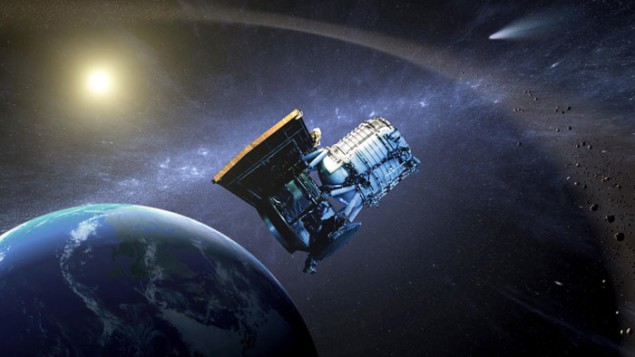
A dormant NASA space telescope is to be given a new lease of life – to sniff out near-Earth objects that could be on a collision course with our planet. Agency officials have decided to reactivate WISE, the Wide-field Infrared Survey Explorer that was mothballed in 2011 after spending two years studying the universe.
Originally launched in late 2009, WISE’s main aim was to perform an all-sky survey in the infrared using its 40 cm- diameter telescope to uncover newly born stars and brown dwarfs hidden outside our solar system. Before its hydrogen coolant began running low in late 2010, the telescope was also used for four months to search for comets and asteroids that could pose a threat to our planet (dubbed the NEOWISE project). During 2010 WISE observed about 158,000 rocky bodies out of approximately 600,000 known objects. Its discoveries included 21 comets, more than 34,000 asteroids in the main belt between Mars and Jupiter, and 135 near-Earth objects, some of which were potentially hazardous, before finally being put into hibernation in early 2011.
Space rocks
Using WISE in this way was considered such a success that Lindley Johnson, head of NASA’s Near-Earth Objects Program, has decided to reboot the craft. Scientists believe that the quickest way to protect our planet is to dust off WISE and get it up and running again. Indeed, NASA officials state that many of the asteroids that they are spotting are larger than the Chelyabinsk asteroid that made its way across Russian skies in February, injuring 1500 people when its shockwave left debris and shattered glass in its wake.
The infrared telescope will be revived next month to discover and characterize NEOs that are orbiting within 45 million kilometres from Earth’s path around the Sun. NASA anticipates WISE will use its telescope and infrared cameras to discover about 150 previously unknown NEOs and characterize the size, albedo and thermal properties of about 2000 others – including some that could be candidates for the agency’s recently announced asteroid initiative.
“The team is ready and after a quick checkout, we’re going to hit the ground running,” says Amy Mainzer, NEOWISE principal investigator at NASA’s Jet Propulsion Laboratory in Pasadena. “NEOWISE not only gives us a better understanding of the asteroids and comets we study directly, but it will also help us refine our concepts and mission plans for future, space-based near-Earth-object cataloguing missions.”
After it is reactivated, WISE it will only be used until 2017, when it will slip from its 500 km Sun-synchronous orbit. Lindley Johnson estimates that reinstating the craft will cost about $5m per year in running costs. In a report earlier this month, Johnson said that bringing the telescope out of retirement may be possible within his department’s $20m budget, but that it would be much more feasible if the budget were doubled to $40m in 2014, as has been requested by the Obama administration. However, it remains unclear whether the extra funding will be secured. “Given the current budget environment, we need to ensure that we would have the necessary funding available to pay for the reactivation and operations for a long enough time to make it worthwhile,” Johnson told physicsworld.com.



